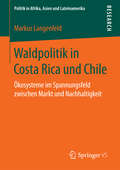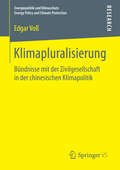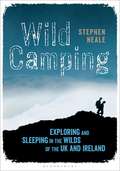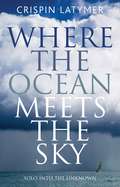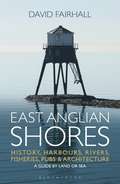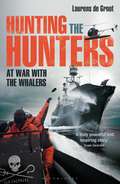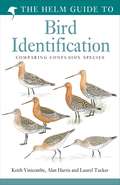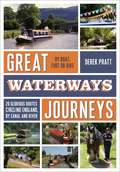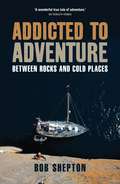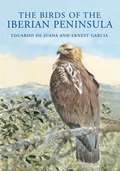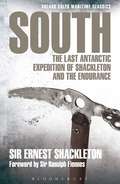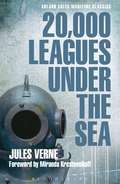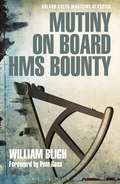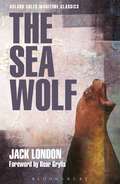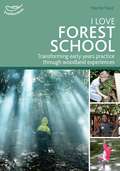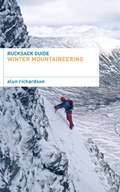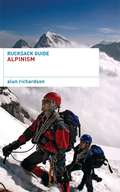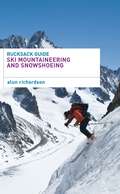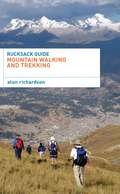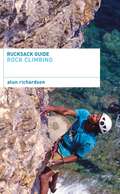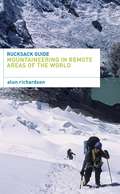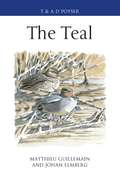- Table View
- List View
Design, Ecology, Politics: Towards the Ecocene
by Joanna BoehnertDesign, Ecology, Politics links social and ecological theory to design theory and practice, critiquing the ways in which the design industry perpetuates unsustainable development.Boehnert argues that when design does engage with issues of sustainability, this engagement remains shallow, due to the narrow basis of analysis in design education and theory. The situation is made more severe by design cultures which claim to be apolitical. Where design education fails to recognise the historical roots of unsustainable practice, it reproduces old errors. New ecologically informed design methods and tools hold promise only when incorporated into a larger project of political change. Design, Ecology, Politics describes how ecological literacy challenges many central assumptions in design theory and practice.By bringing design, ecology and socio-political theory together, Boehnert describes how power is constructed, reproduced and obfuscated by design in ways which often cause environmental harms. She uses case studies to illustrate how communication design functions to either conceal or reveal the ecological and social impacts of current modes of production. The transformative potential of design is dependent on deep-reaching analysis of the problems design attempts to address. Ecologically literate and critically engaged design is a practice primed to facilitate the creation of viable, sustainable and just futures. With this approach, designers can make sustainability not only possible, but attractive.
Waldpolitik in Costa Rica und Chile: Ökosysteme im Spannungsfeld zwischen Markt und Nachhaltigkeit (Politik in Afrika, Asien und Lateinamerika)
by Markus LangenfeldMarkus Langenfeld untersucht, wie die unterschiedlichen Entwicklungen der Waldpolitik in Costa Rica und Chile unter ähnlichen politischen und wirtschaftlichen Bedingungen zu erklären sind. Denn in der Folge eines radikalen politischen Wandels gilt Costa Rica heute als Pionier ökologischer Waldpolitik, was sich in wachsenden Waldbeständen und der Inwertsetzung ihrer Umweltleistungen zeigt. In Chile hingegen spielt die Nachhaltigkeit im Forstsektor weiterhin eine untergeordnete Rolle. Der Autor analysiert Institutionen, Akteure sowie die Rolle der Wertvorstellungen und Überzeugungen in der Waldpolitik beider Länder, um Rückschlüsse über die Voraussetzungen nachhaltiger Entwicklung in Lateinamerika zu ziehen.
Klimapluralisierung: Bündnisse mit der Zivilgesellschaft in der chinesischen Klimapolitik (Energiepolitik und Klimaschutz. Energy Policy and Climate Protection)
by Edgar VoßEdgar Voß zeigt auf, dass auch im autoritär geführten China zivilgesellschaftliche Beratung und Wissensressourcen zur Formulierung von Klimapolitik notwendig sind. Er erforscht den Entstehungsprozess des chinesischen Klimaschutzgesetzes, der vom Staatsapparat als transparent, inklusiv und deliberativ angelegt wurde, um eine theoretisch fundierte Erklärung für die zunehmend pluralistische Ausgestaltung der chinesischen Klimapolitik zu finden. Die Arbeit leistet damit einen Beitrag zur Widerlegung der populären Ansicht, nur ein rational und autoritär geführter Politikapparat, der auf Lobby-Interessen keine Rücksicht nehmen müsse, sei zur Bewältigung des neuartigen Steuerungsproblems Klimawandel fähig.
The Woodland Book: 101 ways to play, investigate, watch wildlife and have adventures in the woods
by Tessa WardleyFrom an author passionate about reconnecting both adults and children with nature, The Woodland Book aims to show anyone with an interest in nature and the great outdoors how to make the most of the unique environments provided by a canopy of trees. Packed with fascinating facts about woodlands including ancient rituals and the wildlife and flora that make it special. You'll learn how to identify different kinds of woodland, assess the age of a tree from a stump, recognise the birds that nest in the canopy by their song and meet other creatures such as bats, badgers and even the odd wild boar. Other activities include learning ancient woodland arts such as coppicing, searching for woodland fruits and building your own shelter and mythical 'green man'. Perfect for adults and children who enjoy climbing, investigating, den building, camping and generally having fun, this book will encourage readers to have fun with nature.
Wild Camping: Exploring and Sleeping in the Wilds of the UK and Ireland
by Stephen NealeFrom getting back to nature with a tent, some matches and a few litres of bottled water, to enjoying a pub dinner and camping out in the garden afterwards, this book shows how to get stuck into wild camping in all its forms. Beautiful wildernesses; tiny budgets; environmentally-friendly… What's not to like? There's an idea that wild camping is illegal in Britain, but it isn't – you just need to know the rules and where to go. This guide will open up this amazing experience for all, covering: - what is wild camping and why bother? - different types (biviing, tenting, motorhoming, caravanning, on the water) - what the law says (Scotland, England, Northern Ireland, Wales, Ireland, EU, waterways) - how landowners are actively encouraging wild camping in the UK (British Waterways, National Trust, Environment Agency, National Farmer's Union etc) - getting started (vital equipment, where to go, when to go, safety) - drinking water and foraging for food The bulk of the book (80%) features the best places to go in England, Wales, Ireland and Scotland, along with stories and tips from experienced wild campers (how to make a fire, how to filter water) and simple recipes for foraged food. With helpful maps and inspiring photos, this guide will give readers the knowledge and the inspiration to escape the noise, clutter and stress of day to day life and go wild.
Where the Ocean Meets the Sky: Solo into the Unknown
by Crispin Latymer'Nobody grows old living a number of years; people grow old only by deserting their ideals. Years wrinkle the skin, but to give up enthusiasm wrinkles the soul.'When Crispin Latymer hit 50 he had a 'What now?' moment - and decided he wanted to sail the Atlantic solo. But he was no intrepid adventurer - Latymer was an ordinary sailor, used to cruising the coasts of the UK, who wanted to do something memorable before he was too old.His voyage turned into an epic. Only two days into his trip, Latymer was caught by Tropical Storm Delta. During the following 23 days he also broke two ribs, was followed by pirates in a scary incident off the Mauritanian coast, and then broke a toe. He describes it all as 'magical'.Writing in an understated, inspirational way that speaks to ordinary sailors just like himself, Crispin's captivating story will encourage other cosy cruisers to break out of their comfort zone and dare to push their boundaries to where the ocean meets the sky.
East Anglian Shores: History, Harbours, Rivers, Fisheries, Pubs and Architecture
by David FairhallFrom Leigh to Lynn – the Thames to the Wash – the coastlines of East Anglia are the most diverse in Great Britain. Norfolk, Suffolk and Essex are communities shaped by their close relationship with the sea and seafaring, from Viking raiders to modern container ships, and hard-working trawlers to elegant racing yachts.In this book, long-time resident David Fairhall explores a landscape that has inspired some of the greatest English painters. He follows gentle rivers that reach far inland from a coastline of marsh, sand and shingle, through fenland and farmland, to rural villages where the past is always present.Rediscovering the East Anglian coastline everyone knows, and uncovering the East Anglian shores only the locals see, this book is written for newcomers and visitors interested in the waterside. It is a treasure trove of local history, endearing wildlife, fascinating architecture and friendly pubs.For anyone whose first impulse on arriving in an unfamiliar town on the coast is to head for the water, this book brings the landscape to life.
Hunting the Hunters: At War with the Whalers
by Laurens De Groot'As the rest of the world stood by and watched, Laurens risked everything to defend these extraordinary mammals from extinction. A truly powerful and inspiring story.' Susan SarandonLaurens de Groot was a detective for the Dutch police, specializing in organized crime and environmental pollution. He was rapidly promoted through the ranks, but became increasingly disillusioned with failed prosecutions and minimal prison sentences. But although as a detective there was little he could do to stop the truly big criminals, there was a more radical option – direct action, not necessarily within the law. Laurens leaves his job, sells up, travels to Australia and joins Sea Shepherd, an international organization protecting marine wildlife. He soon finds himself in the middle of the war against the Japanese whaling fleet operating in the Antarctic whale sanctuary. As the Japanese hunt whales, Laurens and the Sea Shepherd crews hunt them. Their boats are tiny for the wild Southern Ocean, and as well as dealing with the extreme weather they are repeatedly attacked by the Japanese crews and nearly shipwrecked by ice. On one mission, their boat is rammed, cut in two and sunk by a whaling ship. This is war, with no quarter given. Hunting the Hunters is an action-packed and timely account of one man's extraordinary life, as well as an ongoing battle against a powerful nation determined to get its way no matter the cost. It's an important subject, one that a lot of people care about, and as Laurens tells the story in his own words this is a compelling and insightful book.
The Helm Guide to Bird Identification
by Keith Vinicombe Alan HarrisThis book covers difficult identification issues by looking at tricky species pairs or groups of birds, and comparing and contrasting their respective features. Designed as a field companion, it supplements the standard field guides and provides much additional information. As well as detailed texts, the books include extensive illustrations of all relevant ages and plumages of the species concerned.
Great Waterways Journeys: 20 Glorious Routes Circling England, by Canal and River
by Derek PrattThis is a guide to circling England using its inland waterways, by boat or on foot. Along the way we learn about our industrial heritage, how cities grew and thrived, as well as passing through spectacular landscapes and idyllic countryside. Beginning in leafy Surrey and ending at Bristol Docks via north Yorkshire, this 780-mile journey passes through the industrial landscape of the West Midlands and the stunning Pennine hills, as well as famous cities such as Oxford and Bath, taking you via the first canal in Britain, Hampton Court Palace, Cadbury World, idyllic Shropshire villages and iconic pieces of Victorian engineering.The route is split up into different sections, so readers can either take on the whole circumnavigation or one part of it. Celebrating the restoration of the canals that make this journey possible, the book features (and uses, if you're travelling by boat) iconic pieces of waterways history such as the Anderton Lift, the Barton Swing Aqueduct, and the 29 locks at Devizes. Each section of the route is illustrated by a map, and features practical information on locks, tunnels and aqueducts, nearby places of interest, good pubs, useful transport links etc. Giving readers a unique way to discover the beauty and variety of England's waterways, and laying down a new challenge to inland waterways enthusiasts, this is a practical and fascinating guide.
Addicted to Adventure: Between Rocks and Cold Places
by Bob SheptonBob Shepton is an ordained minister in the Church of England in his late 70s, but spends most of his time sailing into the Arctic and making first ascents of inaccessible mountains. No tea parties for this vicar.Opening with the disastrous fire that destroyed his yacht whilst he was ice-bound in Greenland, the book travels back to his childhood growing up on the rubber plantation his father managed in Malaysia, moving back to England after his father was shot by the Japanese during the war, boarding school, the Royal Marines, and the church. We then follow Bob as he sails around the world with a group of schoolboys, is dismasted off the Falklands, trapped in ice, and climbs mountains accessible only from iceberg-strewn water and with only sketchy maps available. Bob Shepton, winner of the 2013 Yachtsman of the Year Award, is an old-school adventurer, and this compelling book is in the spirit of sailing mountaineer HW Tilman, explorer Ranulph Fiennes, climber Chris Bonington and yachtsman Robin Knox-Johnston, all of whom have been either friends of Bob's or an inspiration for his own exploits. Derring do in a dog collar!Ranulph Fiennes: 'A wonderful true tale of adventure.'Bear Grylls: 'You are going to enjoy this...as a Commando, Bob is clearly made of the right stuff!'
The Birds of the Iberian Peninsula
by Eduardo De Juana Ernest GarciaThe Iberian Peninsula is one of Europe's most ornithologically varied regions offering a host of regional specialities. It includes famous birding hotspots such as the Coto Donaña wetlands, mountainous areas such as the Picos de Europa and the Pyrenees, the Mediterranean cork and holm oak forests of the southwest, the migration crossroads of the Strait of Gibraltar and the steppe-like plains of Extremadura and Alentejo. Large numbers of birders from around Europe visit the region to see this wealth of winged wildlife, but to date there has been no comprehensive regional avifauna in English.Birds of the Iberian Peninsula is a national avifauna that fills this gap in the ornithological literature. Full-colour throughout, the book begins with authoritative introductory chapters covering subjects such as geography, climate, habitats, the history of Iberian ornithology and the composition of the avifauna. The species accounts then cover every species recorded in mainland Spain, the Balearic Islands, Portugal, Gibraltar and Andorra, including the many vagrants. For each species there is detailed treatment of distribution – with maps of breeding and wintering ranges – habitat selection, population trends, historical and current status, migration and conservation.
South: The last Antarctic expedition of Shackleton and the Endurance
by Ernest ShackletonIn 1911 Roald Amundsen beat Robert Falcon Scott to the South Pole, and Scott and his colleagues all died on the return journey. Ernest Shackleton, who had served with Scott on a previous expedition, decided that crossing Antarctica from sea to sea was the last great unattempted journey on the continent. His Imperial Trans-Antarctic Expedition of 1914–17 was a failure. But perhaps because it failed, with Shackleton not only surviving but bringing his crew back alive, the expedition became more famous than many of those adventurous voyages that succeeded.After reaching the Weddell Sea off the coast of the Antarctic Peninsula, Shackleton's ship the Endurance became trapped in pack ice and spent 1915 drifting northwards. The Endurance was eventually crushed by the ice and sank, leaving 28 men stranded on the ice. They spent months sheltering from the subzero temperatures as the pack ice continued to drift. Eventually Shackleton accepted they could not rely on rescue and had to help themselves, so he led five men on an 800-mile voyage in an open boat to reach South Georgia, from where he was able to mount a rescue of all of the men he had left behind on the ice. Every one of them survived - a remarkable tribute to his leadership, courage and determination.South is Shackleton's own account of the Imperial Trans-Antarctic Expedition. It is a true story of courageous endurance, survival against the odds and an undeterred sense of adventure. This special edition includes detailed maps so that the reader can see just how extraordinary Shackleton's achievement was, and a specially written Foreword by Sir Ranulph Fiennes, introducing the book from an explorer's perspective.
20,000 Leagues Under the Sea
by Jules VerneAfter a mysterious sea monster damages an ocean liner, the US government assembles a team in New York City to track down the creature and destroy it. French marine biologist Pierre Aronnax receives a last-minute invitation, as does Canadian harpoonist Ned Land. They leave aboard the Abraham Lincoln, bound for Cape Horn and then the Pacific Ocean.But all is not as it seems. When they find the monster and attack, the Abraham Lincoln is damaged and Aronnax and Land end up thrown onto the monster's hide. Except where there should be flesh there is metal. The monster is in fact a submarine called the Nautilus, captained by a mysterious renegade named Nemo, who swiftly takes his former pursuers captive aboard his impossible vessel and then dives deep beneath the waves. So begins the adventure of a lifetime for Aronnax and Land, as Nemo refuses to ever let them leave in case they reveal the truth about the Nautilus. Nemo is on a mission to seek out scientific knowledge and wreak revenge on the civilisation that destroyed his family, a mission that sees the Nautilus explore shipwrecks, hunt sharks, visit the real Atlantis, get attacked by a giant squid and end up stuck in a terrible whirlpool. With Twenty Thousand Leagues Under the Sea, Jules Verne can rightly be considered one of the founding fathers of science fiction. This special edition is based on the original translation that popularised the novel in the English-speaking world, and features an insightful Foreword by naturalist, television presenter and diver Miranda Krestovnikoff.
Mutiny on Board HMS Bounty
by William BlighOn 28th April 1789 a small and unremarkable merchant vessel became one of the most famous ships in maritime history. HMS Bounty was under the command of 34-year-old Lieutenant William Bligh, an inexperienced commander who lacked the respect of a crew attracted to the promise of an easy life in a Tahitian paradise.Fletcher Christian led half the crew in mutiny against Bligh and after overpowering all resistance, they cast their deposed captain adrift along with those still loyal to him. Luckily for Bligh, his skills as a navigator were better than his skills as a captain and he managed to sail the 23ft boat 3,618 nautical miles to Timor in the Dutch East Indies with no chart or compass, and only a quadrant and a pocket watch for navigation. On returning to England he reported what had happened, and the Royal Navy hunted down and captured most of the mutineers.However, this is only half the story – William Bligh's version. The captured mutineers went on trial and their testimonies give a much less heroic portrait of their former captain, accusing him of unduly harsh treatment. Fletcher Christian's older brother Edward, a judge, oversaw a more balanced account of the mutiny. Of the mutineers who returned to England, only three were hanged; four were acquitted and three pardoned.This book gives the fullest version of the mutiny, allowing Bligh's account to sit alongside those of his detractors. The discrepancies are fascinating, and allow us to make up our own minds about this infamous mutiny.Also includes an exclusive Foreword by former World Sailor of the Year Pete Goss, who offers a unique perspective on the trials and tribulations of the Bounty's crew, whether castaway or mutineer.
The Sea Wolf
by Jack LondonSet adrift after a collision with another vessel, ferry passenger Humphrey van Weyden is picked up by the seal-hunting schooner the Ghost. His relief at being rescued slowly turns into concern once he meets her captain, the brutally terrifying Wolf Larsen. The crew of the Ghost live in terror of their fearsome commander, and van Weyden is not made any safer because Larsen is attracted to his new passenger's comparable intelligence.Van Weyden's time aboard the Ghost turns him from a gentle, domesticated man into an altogether tougher soul as he is caught between Larsen and his crew during the rescue of other castaways, an attempted mutiny, a cataclysmic storm and the appearance of Wolf's equally terrible brother, Death Larsen.Wolf Larsen is one of the greatest characters in early 20th century American fiction. Like Captain Ahab before him, he is a man who has spent too long at sea. We might assume he has become inhuman, but the novel gradually but subtly reveals that it was the nature of life at the mercy of the angry oceans that turned him into the sea wolf.This special edition includes an exclusive Foreword by adventurer Bear Grylls, which takes a fascinating look at the character of Wolf Larsen from the perspective of someone who has also stared nature in its unforgiving face.
I Love Forest School: Transforming early years practice through woodland experiences
by Martin PaceThis is not a treatise to get children into the outdoors – that is acknowledged as read. This is a book which considers the following: (i) Different approaches educators can take to working with children in outdoor environments (ii) The benefits of each approach, favouring those which are more child-led. (iii) The book will examine how practice in the woodland can influence educators and how they can support children's learning outdoors and indoors. The book will bring new understandings to practice in the nursery garden or school grounds, and will include an evaluation of how practice at Reflections Nursery has changed and developed in this context.
Rucksack Guide - Winter Mountaineering
by Alun RichardsonRucksack Guide - Winter Mountaineering is your essential handbook for the winter mountain. It offers concise guidance and support for whatever situations you might find yourself in, including:technical skills: tips and reminders on the key techniques equipment: from choosing the right crampons to ice climbing navigation: various techniques to help in a range of weather conditionssafety: essential procedures to ensure the safety of yourself, your party and others on the mountainemergencies: guidance on what to do in extreme situations.The book is colour-coded for easy reference and all information is presented in lists and tables, making it simple to understand in testing conditions.The Rucksack Guide series is adapted from Mountaineering: the essential skills for mountain walkers and climbers, the definitive handbook for hill walkers, climbers and mountaineers.
Rucksack Guide - Alpinism
by Alun RichardsonRucksack Guide - Alpinism is your essential handbook when on the mountain. It offers concise guidance and support for whatever situations you might find yourself in, including:technical skills: tips and reminders on the key techniques the Alpine environment: dealing with hazards, altitude and avalanches navigation: various techniques to help in a range of weather conditions safety: essential procedures to ensure the safety of yourself, your party and others on the mountain emergencies: guidance on what to do in extreme situations. The book is colour-coded for easy reference and all information is presented in lists and tables, making it simple to understand in testing conditions.The Rucksack Guide series is adapted from Mountaineering: The essential skills for mountain walkers and climbers, the definitive handbook for hill walkers, climbers and mountaineers.
Rucksack Guide - Ski Mountaineering and Snowshoeing
by Alun RichardsonRucksack Guide - Ski Mountaineering and Snowshoeing is your essential handbook for when on the mountain. It offers concise guidance and support for whatever situations you might find yourself in, including:technical skills: tips and reminders on the key techniques equipment: choosing the right skis and looking after them finding the best snow: testing for weak spots and crossing crevasses safety: essential procedures to ensure the safety of yourself, your party and others on the mountain emergencies: guidance on what to do in extreme situations.The book is colour-coded for easy reference and all information is presented in lists and tables, making it simple to understand in testing conditions.The Rucksack Guide series is adapted from Mountaineering: The essential skills for mountain walkers and climbers, the definitive handbook for hill walkers, climbers and mountaineers.
Rucksack Guide - Mountain Walking and Trekking
by Alun RichardsonRucksack Guide: Mountain Walking and Trekking is your essential handbook for when on the mountain. It offers concise guidance and support for whatever situations you might find yourself in, including: technical skills - tips and reminders on the key techniques weather - from interpreting weather maps to dealing with thunderstorms navigation - various techniques including using a compass the setting the map safety - essential procedures to ensure the safety of yourself, your party and others on the mountain emergencies - guidance on what to do in extreme situations.The book is colour-coded for easy reference and all information is presented in lists and tables, making it simple to understand in testing conditions.The Rucksack Guide series is taken from Mountaineering: The essential skills for mountain walkers and climbers - the definitive handbook for hill walkers, climbers and mountaineers.
Rucksack Guide - Rock Climbing
by Alun RichardsonRucksack Guide - Rock Climbing is your essential handbook when climbing. It offers concise guidance and support for anysituation you might find yourself in, including: technical skills: tips and reminders on the key climbing techniquesrope work: what knots to use in certain situations and how to tie themtypes: aid climbing, free climbing, big walling and ice climbingsafety: essential procedures to ensure the safety of yourself, your party and others on the rock faceemergencies: guidance on what to do in extreme situations.The book is colour-coded for easy reference and all information ispresented in lists and tables, making it simple to understand intesting conditions.The Rucksack Guide series is taken from Mountaineering: The essentialskills for mountain walkers and climbers, the definitive handbook forhill walkers, climbers and mountaineers.
Rucksack Guide - Mountaineering in Remote Areas of the World
by Alun RichardsonRucksack Guide - Mountaineering in Remote Areas of the World is your essential handbook for planning and undertaking mountaineering expeditions around the world. It offers concise guidance and support for whatever situations you might find yourself in, including:where to go: tips on gaining sponsorship, permits and the best times to visit dangerous animals: dealing with creatures that bite, sting or suck your blood environmental issues: minimising your impact on the environment safety: essential procedures to ensure the safety of yourself, your party and others on the mountain emergencies: guidance on what to do in extreme situations.The book is colour-coded for easy reference and all information is presented in lists and tables, making it simple to understand in testing conditions.The Rucksack Guide series is taken from Mountaineering: The essential skills for mountain walkers and climbers, the definitive handbook for hill walkers, climbers and mountaineers.
The Teal
by Matthieu Guillemain Johan ElmbergSmall, noisy and colourful, the Teal is a familiar duck throughout the wetlands and waterways Europe and Asia. Once hunted extensively for the pot, its numbers have recovered and it is now one of our commonest species of waterfowl. A flagship species for wetland conservation, the Teal is also an excellent model species for ecological research, and this forms the spine of this new Poyser monograph. The Teal looks at distribution and trends in numbers, foraging ecology, breeding behaviour), population dynamics, management and conservation of teal, looking at both the Eurasian Common Teal and its North American equivalent, the Green-winged Teal (which until relatively recently was considered to be the same species). The book provides a scientifically robust account on which wetland managers, research scientists and the ornithological community may rely, with wider implicatons for the conservation and management of other waterfowl, and for ecological research in general.
Field Guide to Invasive Plants and Animals in Britain
by Olaf Booy Max Wade Helen RoyThe impact of invasive organisms is second only to habitat loss as a threat to biodiversity and yet, despite increasing ecological awareness, people remain largely unaware of these plants and animals and their potentially devastating impact. Although most biological introductions fail, many prove successful and these can prove disastrous for native fauna and flora.This field guide will enable the identification of a range of invasive plants and animals now found in Britain. Though these species are of particular concern to conservationists there has previously been no unified guide devoted to their recognition. This book will act both as an ID guide, appealing to the amateur naturalist, and as an important tool for ecologists and land managers attempting to tackle the problem posed by invasive species.

